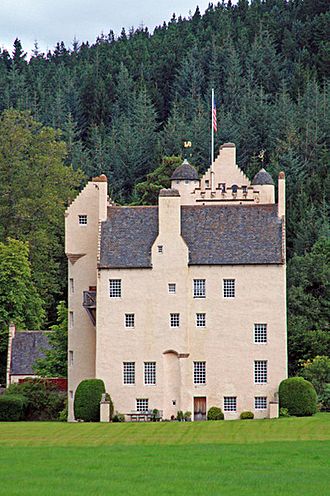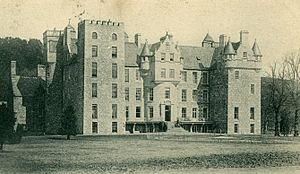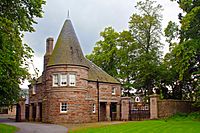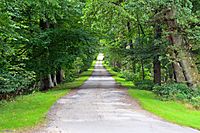Aboyne Castle facts for kids
Quick facts for kids Aboyne Castle |
|
|---|---|
 |
|
| General information | |
| Location | Aboyne |
| Town or city | Aberdeenshire |
| Country | Scotland |
| Coordinates | 57°05′05″N 2°47′00″W / 57.0846°N 2.7833°W |
Aboyne Castle is an old castle from the 1200s. It's located in Aberdeenshire, Scotland, about 1.2 kilometers (0.75 miles) north of the town of Aboyne. The castle was built in a smart spot near the River Dee. This location helped control an important route through the Mounth mountains. Aboyne Castle was once empty and falling apart, but it was fixed up in 1979 by the current Marquess of Huntly.
Contents
Castle Design and History
The castle was first built by the Byset family before 1233. It started as a "motte-and-bailey" castle, which means it had a large earth mound (the motte) with a wooden tower on top, and a fenced area (the bailey) below. In 1307, King Edward I gave instructions to make it stronger.
Later, the castle was rebuilt with stone, becoming a strong "keep" (a main tower). In 1671, a part of the castle was rebuilt as a "tower house" by Charles, the first Earl of Aboyne. You can still see parts of this today. A larger "mansion house" was added in 1701, and an east wing was built in 1801.
In the late 1800s, more changes were made. The kitchen was improved with granite, and the mansion house got fancy "baronial-style" decorations. Some restoration work was done by George Truefitt. The castle was updated again in 1986 by Ian Begg.
The castle has three main floors, plus a basement and an attic. Some sides of the castle are perfectly balanced (symmetrical), while others are not. On the north side, which is the entrance, there's a special panel with a family crest and a weather vane. The oldest part of the castle is a round tower in the northwest corner. This tower has five floors and a walkway at the top. A similar tower was later added to the northeast.
The castle walls are covered in a rough plaster called "harled" and painted with a white lime wash. It has several small towers called "turrets," and some people believe there might be a secret passageway and a monk's room inside. The windows have small panes of glass, and the roof is made of grey slate. Stone steps lead up to the main entrance. Just north of the castle, there's a walled courtyard.
Who Owned the Castle?
In 1242, the Byset family, who owned Aboyne Castle, had some trouble and left Scotland. The castle then went to the Knights Templar, a famous group of knights.
After that, it was owned by the Frasers of Cowie. Around 1355, it passed to Sir William de Keith, who was the Great Marischal of Scotland, through marriage. In 1449, his great-granddaughter, Joan, married Alexander Gordon, 1st Earl of Huntly. This brought the castle into the Gordon family. The Marquis of Huntly family has owned Aboyne Castle ever since, for over 500 years!
The Castle Grounds
The land around Aboyne Castle is very large and beautiful. It includes many planted trees and gardens on both sides of the River Dee. There's also a small lake called the Loch of Aboyne.
The castle grounds are also used for fly fishing on the River Dee. This is done in agreement with the Glen Tanar Estate. The Loch of Aboyne is an artificial lake within the castle grounds. It's about 0.6 kilometers (0.37 miles) long and 0.47 kilometers (0.29 miles) wide, and it has small islands. A stream near the castle is still called Allach, and the Allach Bridge was built over it.
The Formaston Stone
A very old and important stone called the Formaston Stone is kept at the castle. It dates back to between 800 and 1000 AD. This stone has a mirror symbol, a decorated Celtic cross, and writing in an ancient alphabet called Ogham.
Keeping the Castle Safe
Aboyne Castle, along with its gateway, courtyard, and northern walls, was officially recognized as a "category B" listed building on November 24, 1972. This means it's an important historical building that needs to be protected.
Other parts of the estate are also listed. The walled garden and garden house from the early 1800s, and a small building called the Wee House, were listed in 2000. The Allach Bridge, which has three arches and was built in 1787 from grey granite, was also listed as a category B building in 2000.




